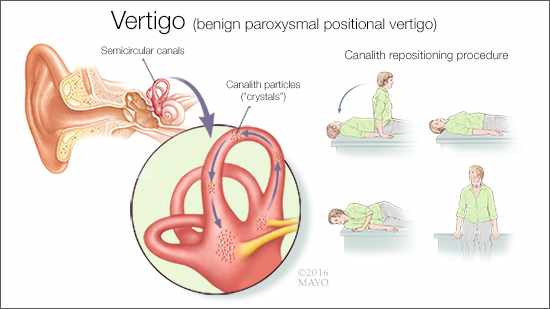
DEAR MAYO CLINIC: What causes BPPV, and is there a treatment for it?
ANSWER: Benign paroxysmal positional vertigo, or BPPV, is one of the most common causes of vertigo (dizziness). BPPV is characterized by sudden bursts of vertigo that are caused by head movements, such as sitting up or tilting your head. What leads to the development of BPPV isn’t known, but it’s more common in older adults.
Once you develop BPPV, the bursts of dizziness typically occur after you change the position of your head, such as when you roll over in bed. BPPV also may cause nausea and possibly vomiting, with a feeling of lingering fatigue, queasiness or a feeling of imbalance. Without treatment, these symptoms may last for as little as one day to as long as weeks or months. Fortunately, with proper diagnosis, a simple procedure may be all it takes to treat BPPV.
Your sense of balance relies on a finely tuned system that coordinates sensory information (from nerves throughout your body) and visual information to help you determine the position of your body relative to your surroundings.
BPPV is a result of tiny crystals in your inner ear being out of place. The crystals make you sensitive to gravity and help you to keep your balance. Normally, a jelly-like membrane in your ear keeps the crystals where they belong. If the ear is damaged — often by a blow to the head — the crystals can shift to another part of the ear. When they are out of place, the crystals make you sensitive to movement and position changes that normally don’t affect you, sparking vertigo.
Since there are numerous causes of imbalance and dizziness — and more than one cause may occur at the same time — proper diagnosis is critical to effective treatment. With BPPV, the primary diagnostic test is called the Dix-Hallpike test. During the test, you are placed in the position that usually causes your vertigo. Then, your doctor checks for involuntary, jerking eye movements (nystagmus) that are associated with BPPV. The test may be done in different ways to determine which side is causing the problem.
Treatment for BPPV can be done in your doctor’s office, or with an audiologist or certain physical therapists. The treatment includes a series of body movements that reposition the crystals in your inner ear, where they no longer cause symptoms. Two procedures used are the canalith repositioning procedure and the Lempert roll. With canalith repositioning, just one time through the procedure is often enough to correct BPPV. However, it may be necessary to perform the procedure up to several times with brief breaks between before BPPV is eliminated. Your doctor will be able to detect treatment completion when there’s no sign of nystagmus in your eyes. After the treatment, you’ll likely be advised to keep your head upright for the rest of the day.
Although the canalith repositioning procedure is highly effective, BPPV can linger or return. This is more likely to happen in older adults. If this happens, you may be taught how to do the canalith repositioning procedure on your own at home.
If dizziness persistently lingers or continues to return, a visit to a specialist, such as an audiologist or vestibular therapist, may be warranted. A specialized evaluation can determine if BPPV is being treated properly or if other factors affecting balance may be in play.
Some people continue to have symptoms of impaired imbalance and dizziness after BPPV has been resolved. In these cases, working with a physical therapist specializing in vestibular and balance rehabilitation can help you decrease dizziness symptoms and regain balance. (adapted from Mayo Clinic Health Letter) — Dr. Neil Shepard, Audiology, Mayo Clinic, Rochester, Minnesota







